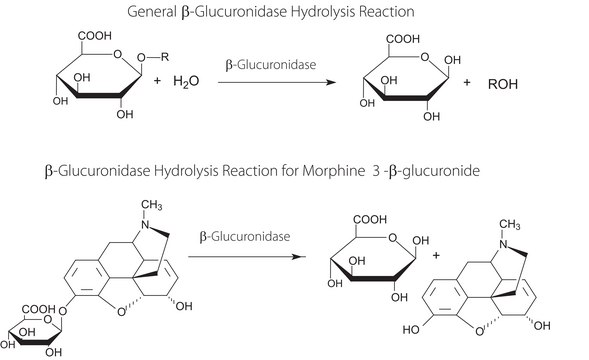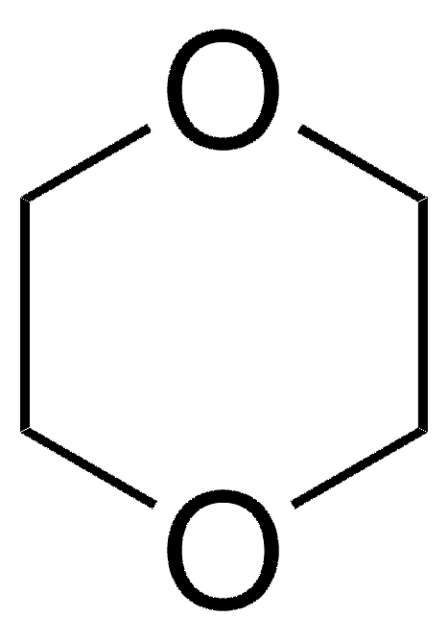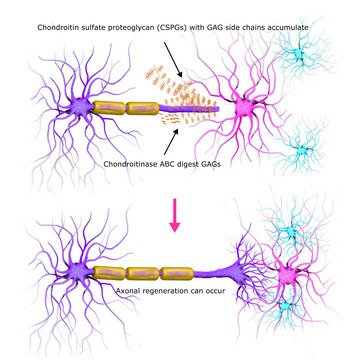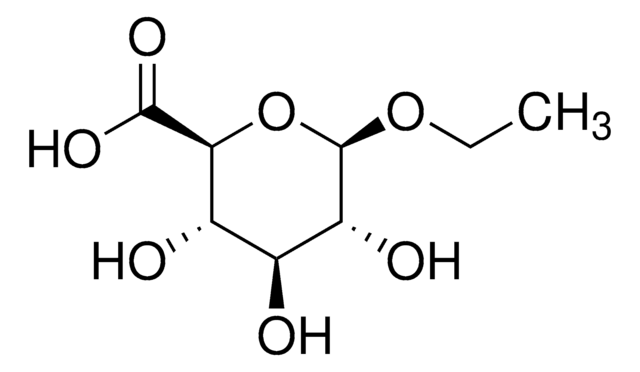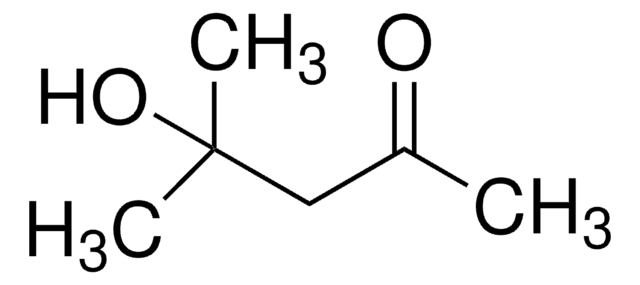Recommended Products
biological source
Escherichia coli K12
Quality Level
form
solution
mol wt
Mr ~220 kDa
packaging
pkg of 1 mL (03707580001)
pkg of 15 mL (03707601001)
pkg of 5 mL (03707598001)
manufacturer/tradename
Roche
storage condition
(Keep container tightly closed in a dry and well-ventilated place.)
parameter
48 °C optimum reaction temp.
technique(s)
activity assay: suitable
color
colorless
optimum pH
6.0-6.5
solubility
water: soluble
suitability
suitable for enzyme test
UniProt accession no.
application(s)
detection
sample preparation
storage temp.
2-8°C
Gene Information
Escherichia coli ... uidA(946149)
Related Categories
General description
Glucuronidase at 25 °C, or 140 U/mg at 37 °C, at pH 7 with 4-nitrophenyl-β-D-glucuronide as substrate; 1 ml β-Glucuronidase contains at least 140 U at 37 °C.
Specificity
Cleaves terminal glucuronic acid which is β-linked to mono-, oligo- or polysaccharides or phenol.
Application
β-Glucuronidases have been used extensively in research and analytical laboratories for the enzymatic hydrolysis of steroid β-glucuronides. β-Glucuronidase is used:
- for the hydrolysis of steroid conjugates (glucuronides) in urine (pH 6.0–6.5)
- in doping analysis
- for the detection of benzodiazepine in small doses.
- during sample preparation to cleave off glucuronides prior to GC-MS, HPLC, immunoassays, or other analytical methods.
Biochem/physiol Actions
Glucuronidation is one of the basic principles of metabolism. Many substances presented to the human body undergo metabolic processing that includes conjugation with glucuronic acid by UDP-glucuronosyltransferases (UGTs). β-Glucuronidase, also known as β-D-glucuronoside glucuronosohydrolase, catalyzes the transfer of a glucuronyl group to many biological and pharmacologically active endogenous and exogenous molecules. Glucuronide is in general, more soluble, less toxic, and more easily excreted by the human body compared to the original molecule. To analyze these drug conjugates that are present in body fluids, such as urine and plasma, deconjugation of the glucuronide is necessary. Enzymatic hydrolysis prior to detection is essential to achieving high sensitivity during analysis. After hydrolysis, the sample may be analyzed by mass spectroscopy, gas chromatography, HPLC, immunoassays, or other analytical methods.
Features and Benefits
β-Glucuronidase from E. coli is highly specific for β-glucuronides, and is capable of very quickly hydrolyzing steroid β-glucuronides as well as cleaving many other types of glucuronides, such as benzodiazepine, opioid, and cannabinoid. β-Glucuronidase is used for the enzymatic hydrolysis of glucuronides in biological fluids, primarily urine. Substances used for doping are conjugated with glucuronides, which means that effective doping analysis relies very often on the enzymatic cleavage of conjugated drug molecules by β-glucuronidase.
- Perform fast analysis due to the enzyme′s high specific activity.
- Quickly screen for steroids, benzodiazepines, cannabinoids, and opioids.
- Save time by developing your procedure without the need to clean up the reaction or buffer the urine.
Unit Definition
The international unit of β-glucuronidase activity is the enzyme activity that increases the rate of release of 4-nitrophenol from 4-nitrophenyl-β-D-glucuronide (4NPG) at a temperature of +25 °C and pH 7.0 by 1 μM.
The Fishman unit was previously used. This unit is the release of phenolphthalein from its glucuronide (PPG). It is not possible to measure the relative activities of different preparations for steroid β-glucuronides by comparing their activities with respect to PPG. Many preparation do not catalyze the hydrolysis of PPG, 4NPG, or the various steroid β-glucuronides in urine equally. The choice of 4NPG as standard substrate is based on the following considerations:
The Fishman unit was previously used. This unit is the release of phenolphthalein from its glucuronide (PPG). It is not possible to measure the relative activities of different preparations for steroid β-glucuronides by comparing their activities with respect to PPG. Many preparation do not catalyze the hydrolysis of PPG, 4NPG, or the various steroid β-glucuronides in urine equally. The choice of 4NPG as standard substrate is based on the following considerations:
- The Michaelis concentrations for the two substrates are similar (KM = 2 ×10-4 M for 4 NPG and KM = 6 ×10-5 M for PPG), but the corresponding rates of hydrolysis differ:
- 4NPG is hydrolysed about 5 × as fast as PPG;
- For PPG, inhibition by excess substrate occurs; this is not observed using 4NPG.
Physical form
Solution in 50% glycerol, pH approximately 6.5
(15 ml in one bottle)
(15 ml in one bottle)
Other Notes
The E.coli β-glucuronidase enzyme is essentially free of sulfatase activity and is especially efficient in cleaving steroid and benzodiazepine conjugates.
For life science research only. Not for use in diagnostic procedures.
For life science research only. Not for use in diagnostic procedures.
Legal Information
The sale of the Product does not exhaust or grant any rights in third party patents including patents of companies of the F. Hoffmann - La Roche AG group of companies, in particular, for the use of modified antibodies obtained by using the product.
Storage Class Code
12 - Non Combustible Liquids
WGK
WGK 1
Flash Point(F)
No data available
Flash Point(C)
No data available
Regulatory Information
常规特殊物品
Choose from one of the most recent versions:
Already Own This Product?
Find documentation for the products that you have recently purchased in the Document Library.
T V Zenser et al.
Drug metabolism and disposition: the biological fate of chemicals, 27(9), 1064-1067 (1999-08-26)
Individuals exposed to carcinogenic aromatic amines excrete arylamine N- and O-glucuronide metabolites. This study assessed the susceptibility of selected glucuronides to hydrolysis by human and Escherichia coli beta-glucuronidase. N- or O-glucuronides were prepared with the following aglycones: benzidine, N-acetylbenzidine, N'-hydroxy-N-acetylbenzidine
Alan V Rincon et al.
Psychoneuroendocrinology, 120, 104774-104774 (2020-06-24)
Neuroendocrine research on the formation of social bonds has primarily focused on the role of nonapeptides. However, steroid hormones often act simultaneously to either inhibit or facilitate bonding. Testosterone is proposed to mediate a trade-off between male mating effort and
LC-MS/MS-Based Assay for Free and Deconjugated Testosterone and Epitestosterone in Rat Urine and Serum.
Jenkinson C
Journal of Analytical and Bioanalytical Techniques , S5, doi-doi (2014)
Anne-Sophie Morisset et al.
The British journal of nutrition, 102(2), 195-200 (2009-07-10)
There has been a growing interest in lignans, a class of phyto-oestrogens, because of their potentially favourable effects on human health. The aim of the present study was to compare the metabolic profile of post-menopausal women consuming various amounts of
Alan V Rincon et al.
General and comparative endocrinology, 281, 117-125 (2019-05-31)
The development of methods to quantify hormones from non-invasively collected samples such as urine or feces has facilitated endocrinology research on wild-living animals. To ensure that hormone measurements are biologically meaningful, method validations are strongly recommended for each new species
Our team of scientists has experience in all areas of research including Life Science, Material Science, Chemical Synthesis, Chromatography, Analytical and many others.
Contact Technical Service
